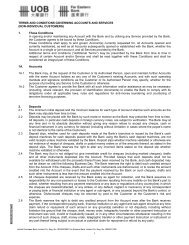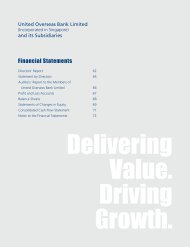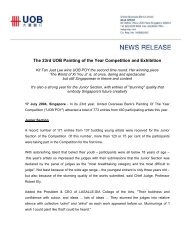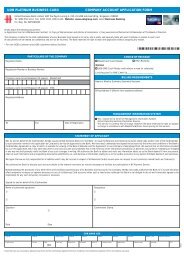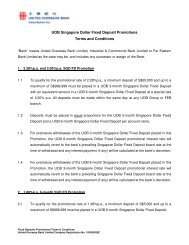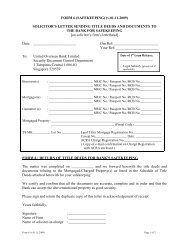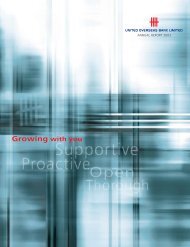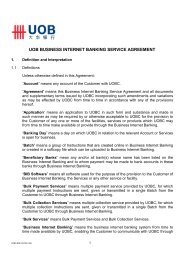UOB Annual Report 2002 - United Overseas Bank
UOB Annual Report 2002 - United Overseas Bank
UOB Annual Report 2002 - United Overseas Bank
Create successful ePaper yourself
Turn your PDF publications into a flip-book with our unique Google optimized e-Paper software.
Risk Management<br />
Credit and Country Risk Management<br />
Credit Risk<br />
Counter-party and credit risk is defined as the potential loss arising from any failure by customers<br />
to fulfil their obligations, as and when they fall due. All credit exposures, whether on-balance sheet<br />
or off-balance sheet, are assessed. These obligations may arise from lending, trade finance,<br />
investment, receivables under derivative and foreign exchange contracts and other credit-related<br />
activities undertaken by the Group.<br />
The Credit Committee, under delegated authority from the Board of Directors, approves credit<br />
policies, guidelines and procedures to control and monitor such risks. It has day-to-day responsibility<br />
for identifying and managing portfolio and risk concentration issues, including country exposure<br />
and industry sector exposure. The risk parameters for accepting credit risk are clearly defined and<br />
complemented by policies and processes to ensure that the Group maintains a well diversified and<br />
high quality credit portfolio. The decisions of the Credit Committee and its monthly risk management<br />
reports are reviewed by the Executive Committee of the Board.<br />
Credit discretionary limits are delegated to officers of individual business units, depending on their<br />
levels of experience. Approval of all credits is granted in accordance with credit policies and<br />
guidelines. Defined credit risk parameters include single borrower, obligor, security concentrations,<br />
identified high-risk areas, maximum tenor and acceptable structures, and collateral types.<br />
Additional policies are in place to govern the approval of 'Related Parties' credit facilities. 'Related<br />
Parties' refer to individuals or companies with whom the authorised credit approving authority<br />
and/or his/her immediate family members have a relationship, whether as director, partner,<br />
shareholder or any other relationship which would give rise to a potential conflict of interest.<br />
Credit Risk Management<br />
Formulation of Credit Policies and<br />
Risk Parameters<br />
• Acceptable Collateral/Concentrations<br />
• Maximum Advance Margin for Collateral<br />
• Maximum Individual<br />
Borrower Exposure<br />
• Maximum Tenor<br />
of Facility<br />
Credit Risk Mitigation<br />
• Credit Review<br />
- Compliance<br />
-Credit Quality Assurance<br />
• Special Loans (Recovery/Consultation)<br />
Portfolio Review<br />
• Concentration Analysis<br />
• Stress Testing<br />
Procedures on Classification of Accounts<br />
• Auto-Classification based on Ageing<br />
of Past Dues<br />
• De-Classification<br />
• Provisioning of<br />
Non-Performing Loans<br />
Discretionary Limits<br />
• Delegation of<br />
Discretionary<br />
Limits tiered by:<br />
- Corporate Grade<br />
- Portfolio<br />
-Track Record<br />
Country of Risk<br />
• Setting of Country Limits<br />
• Analysis of Country Risks<br />
Credit Rating System<br />
• Calibration of Borrower Risk<br />
• Credit Alert<br />
Credit Policies/Procedures<br />
• Communication of Policies<br />
and Procedures through<br />
Online Distribution<br />
• Upgrading of Skills through<br />
Continuous Training<br />
UNITED OVERSEAS BANK 25




